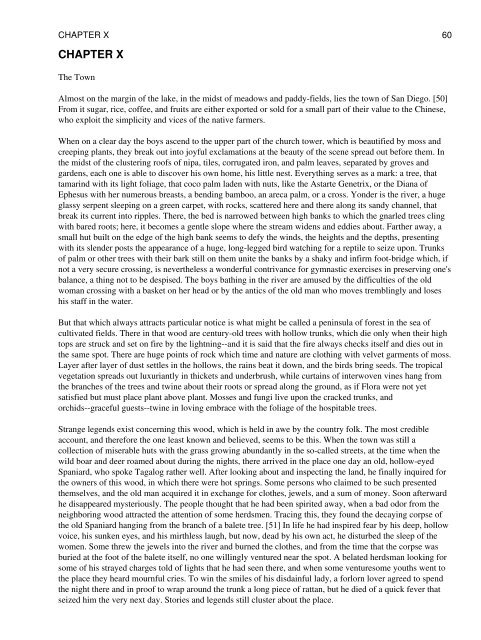The Social Cancer, by José Rizal - Home
The Social Cancer, by José Rizal - Home
The Social Cancer, by José Rizal - Home
You also want an ePaper? Increase the reach of your titles
YUMPU automatically turns print PDFs into web optimized ePapers that Google loves.
CHAPTER X 60<br />
CHAPTER X<br />
<strong>The</strong> Town<br />
Almost on the margin of the lake, in the midst of meadows and paddy-fields, lies the town of San Diego. [50]<br />
From it sugar, rice, coffee, and fruits are either exported or sold for a small part of their value to the Chinese,<br />
who exploit the simplicity and vices of the native farmers.<br />
When on a clear day the boys ascend to the upper part of the church tower, which is beautified <strong>by</strong> moss and<br />
creeping plants, they break out into joyful exclamations at the beauty of the scene spread out before them. In<br />
the midst of the clustering roofs of nipa, tiles, corrugated iron, and palm leaves, separated <strong>by</strong> groves and<br />
gardens, each one is able to discover his own home, his little nest. Everything serves as a mark: a tree, that<br />
tamarind with its light foliage, that coco palm laden with nuts, like the Astarte Genetrix, or the Diana of<br />
Ephesus with her numerous breasts, a bending bamboo, an areca palm, or a cross. Yonder is the river, a huge<br />
glassy serpent sleeping on a green carpet, with rocks, scattered here and there along its sandy channel, that<br />
break its current into ripples. <strong>The</strong>re, the bed is narrowed between high banks to which the gnarled trees cling<br />
with bared roots; here, it becomes a gentle slope where the stream widens and eddies about. Farther away, a<br />
small hut built on the edge of the high bank seems to defy the winds, the heights and the depths, presenting<br />
with its slender posts the appearance of a huge, long-legged bird watching for a reptile to seize upon. Trunks<br />
of palm or other trees with their bark still on them unite the banks <strong>by</strong> a shaky and infirm foot-bridge which, if<br />
not a very secure crossing, is nevertheless a wonderful contrivance for gymnastic exercises in preserving one's<br />
balance, a thing not to be despised. <strong>The</strong> boys bathing in the river are amused <strong>by</strong> the difficulties of the old<br />
woman crossing with a basket on her head or <strong>by</strong> the antics of the old man who moves tremblingly and loses<br />
his staff in the water.<br />
But that which always attracts particular notice is what might be called a peninsula of forest in the sea of<br />
cultivated fields. <strong>The</strong>re in that wood are century-old trees with hollow trunks, which die only when their high<br />
tops are struck and set on fire <strong>by</strong> the lightning--and it is said that the fire always checks itself and dies out in<br />
the same spot. <strong>The</strong>re are huge points of rock which time and nature are clothing with velvet garments of moss.<br />
Layer after layer of dust settles in the hollows, the rains beat it down, and the birds bring seeds. <strong>The</strong> tropical<br />
vegetation spreads out luxuriantly in thickets and underbrush, while curtains of interwoven vines hang from<br />
the branches of the trees and twine about their roots or spread along the ground, as if Flora were not yet<br />
satisfied but must place plant above plant. Mosses and fungi live upon the cracked trunks, and<br />
orchids--graceful guests--twine in loving embrace with the foliage of the hospitable trees.<br />
Strange legends exist concerning this wood, which is held in awe <strong>by</strong> the country folk. <strong>The</strong> most credible<br />
account, and therefore the one least known and believed, seems to be this. When the town was still a<br />
collection of miserable huts with the grass growing abundantly in the so-called streets, at the time when the<br />
wild boar and deer roamed about during the nights, there arrived in the place one day an old, hollow-eyed<br />
Spaniard, who spoke Tagalog rather well. After looking about and inspecting the land, he finally inquired for<br />
the owners of this wood, in which there were hot springs. Some persons who claimed to be such presented<br />
themselves, and the old man acquired it in exchange for clothes, jewels, and a sum of money. Soon afterward<br />
he disappeared mysteriously. <strong>The</strong> people thought that he had been spirited away, when a bad odor from the<br />
neighboring wood attracted the attention of some herdsmen. Tracing this, they found the decaying corpse of<br />
the old Spaniard hanging from the branch of a balete tree. [51] In life he had inspired fear <strong>by</strong> his deep, hollow<br />
voice, his sunken eyes, and his mirthless laugh, but now, dead <strong>by</strong> his own act, he disturbed the sleep of the<br />
women. Some threw the jewels into the river and burned the clothes, and from the time that the corpse was<br />
buried at the foot of the balete itself, no one willingly ventured near the spot. A belated herdsman looking for<br />
some of his strayed charges told of lights that he had seen there, and when some venturesome youths went to<br />
the place they heard mournful cries. To win the smiles of his disdainful lady, a forlorn lover agreed to spend<br />
the night there and in proof to wrap around the trunk a long piece of rattan, but he died of a quick fever that<br />
seized him the very next day. Stories and legends still cluster about the place.


